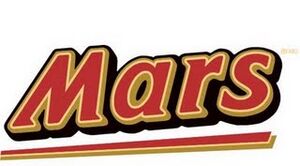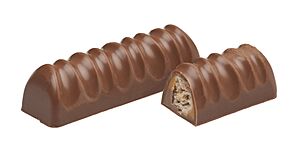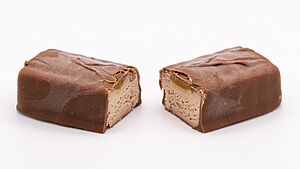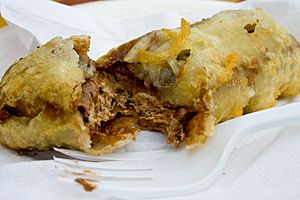Mars bar facts for kids
|
UK-style Mars bar
|
|||||||
| Place of origin | England | ||||||
|---|---|---|---|---|---|---|---|
| Region or state | Worldwide | ||||||
| Created by | Forrest Mars | ||||||
| Invented | 1932 | ||||||
| Main ingredients | Chocolate, caramel, nougat | ||||||
| 228 or about 230 kcal | |||||||
|
|||||||
The Mars bar is a popular chocolate bar made by Mars, Incorporated. It was first created in 1932 in Slough, England, by Forrest Mars, Sr.. This yummy treat has a soft nougat center and gooey caramel, all covered in smooth milk chocolate.
There was also a different version of the Mars bar made in America. It had nougat and toasted almonds, later with caramel too. This American version stopped being made in 2002. However, a similar candy bar called "Snickers Almond" was introduced the next year.
Contents
Different Kinds of Mars Bars
Mars Bars Around the World
In most countries, a Mars bar is the chocolate bar with nougat and caramel, covered in milk chocolate. If you're in the United States, this exact bar is known as the Milky Way bar.
The very first Mars bar was made in Slough, England, in 1932. Forrest Mars, Sr., whose dad made the Milky Way bar in the US, created it. He changed his dad's recipe a bit to make it taste even better for people in Europe.
Over the years, the Mars bar has changed a little. The size and the amount of each ingredient have been adjusted. This version of the Mars bar is sold almost everywhere, except in the US. It comes in a black wrapper with red letters outlined in gold. An interesting fact: three million Mars bars were sent with the British soldiers during the Falklands War in 1982!
In 2002, the Mars bar got a new look and a slightly different recipe. The nougat became lighter, and the chocolate coating was thinner. The bar also became a bit lighter in weight.
Mars bars come in different sizes. You can find small "Fun Size" bars, "Snack Time" bars, and the regular single bar. The size of the regular Mars bar has been reduced over time. For example, in the UK, it went from 62.5 grams to 51 grams over several years. This change was partly due to rising costs for the company.
Mars Bars in the United States
In the United States, the Mars bar used to be a candy bar with nougat and toasted almonds, covered in milk chocolate. This is the same as what's called a Mars Almond bar in other countries. At first, it didn't have caramel, but caramel was added later. This version was stopped in 2002.
In 2003, a new candy bar called Snickers Almond was introduced. It has nougat, almonds, caramel, and a milk chocolate coating. It's quite similar to the old US Mars bar, but the almond pieces are smaller.
The US Mars bar was brought back for a short time in 2010 and then again in 2016. The 2016 version went back to the "original American recipe" without caramel. You could find it in special stores and online.
If you're in America and want to try the European or Canadian Mars bar, you might find it in grocery stores that sell imported foods.
Other Mars Products
Many other products have been made using the popular Mars name. These include:
- Mars Bites (small pieces of Mars bar)
- Mars Delight (no longer made in the UK)
- Mars Choc Brownie
- Mars Extra Chocolate Drink
- Mars and Mars Midnight Ice Cream bars
- Mars Biscuits (cookies with Mars topping)
- Mars Pods (small crunchy wafer shells with Mars filling, popular in Australia and New Zealand)
- Mars Protein (a Mars bar with more protein and less sugar)
Deep-Fried Mars Bar
A unique way to enjoy a Mars bar is to have it deep-fried! This involves coating the chocolate bar in batter and then frying it. Reports of this unusual treat being sold in Stonehaven, Scotland, go back to 1995. Mars, the company, does not officially approve or endorse this way of eating their bar.
You can find deep-fried Mars bars in some fish-and-chip shops, especially in Scotland. They are also available in places like Singapore, Australia, New Zealand, Canada, Ireland, and the United States.
In Kathmandu, Nepal, some restaurants even use Mars bars as a surprising filling for momo dumplings in tourist areas.









